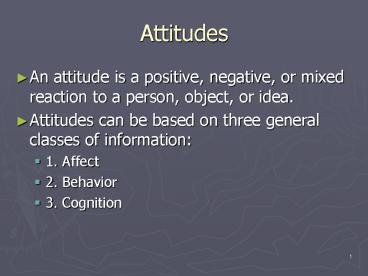Attitudes - PowerPoint PPT Presentation
1 / 17
Title:
Attitudes
Description:
Cognitive Dissonance ... 1. Cognitive Dissonance Theory (Festinger) inconsistency between thoughts ... Use of cognitive dissonance to promote healthy behavior. ... – PowerPoint PPT presentation
Number of Views:40
Avg rating:3.0/5.0
Title: Attitudes
1
Attitudes
- An attitude is a positive, negative, or mixed
reaction to a person, object, or idea. - Attitudes can be based on three general classes
of information - 1. Affect
- 2. Behavior
- 3. Cognition
2
How are Attitudes Formed?
- Learning
- Mere exposurerepeated exposure to a stimulus
increases our feelings about the stimulus. - Direct experience
- Operant conditioning-reward and punishment
- Classical conditioning-association of CS with UCS
- Observational learning-imitation of others
- Media
- Genetics
3
Attitudes and Judgment
- Existing attitudes bias judgments of new
information. - Death penalty study (Lord, Ross, Lepper, 1979)
- Fibrocystic disease and caffeine study (Kunda,
1987)
4
Attitudes and JudgmentData from Kunda (1987)
5
Attitudes and Judgment
- Attitudes also bias recall of old information.
- Introversion/Extraversion study (Sanitioso et
al., 1990)
6
Attitudes and Behavior
- LaPiere (1934) study of attitudes and behavior
towards Chinese people.
7
Attitudes and Behavior
- Factors that moderate the attitude-behavior link
- Strength of attitude
- Specificity of attitude
- Self-focus
- Self-monitoring
8
Self-Monitoring Scale
- 1. I find it hard to imitate the behavior of
other people T F - 2. I can only argue for ideas which I already
believe T F - 3. I have considered being an entertainer T F
- 4. I would probably make a good actor T F
- 5. I have trouble changing my behavior to suit
different people and different situations T F
9
Ajzens Theory of Planned Behavior
Attitude toward a behavior
Subjective norms
Intention
Behavior
Perceived Behavioral control
10
Attitude
Action
11
Cognitive Dissonance
- A state of psychological tension that is aroused
when a person simultaneously holds two thoughts
that contradict one another.
12
Theory of Cognitive Dissonance
- Inconsistency between thoughts
Experience cognitive dissonance
Attempt to reduce dissonance
Change attitude
13
Festinger Carlsmith (1959)
- Participants did boring tasks for 1 hour.
- Paid 1 or 20 to tell another participant that
the tasks were enjoyable. - During interview, asked how much they enjoyed the
tasks.
14
Three Dissonance-Arousing Conditions
- 1. Attitude-behavior inconsistency
- Leads to change in attitude
- 2. Exerting wasted effort
- Leads to effort justification
- 3. Making a difficult decision
- Leads to post-decisional dissonance
15
Two Perspectives on Self-Persuasion
- 1. Cognitive Dissonance Theory (Festinger)
inconsistency between thoughts leads to
unpleasant tension (dissonance), which motivates
people to reduce dissonance by changing thoughts.
16
Two Perspectives on Self-Persuasion
- 2. Self-Perception Theory (Bem) people form and
modify their attitudes by observing their own
behavior.
17
Implications
- Behavior ? Attitude change
- Use of cognitive dissonance to promote healthy
behavior.

